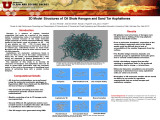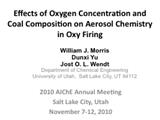TO
Filters: Collection: "ir_eua"
| Title | Date | Subject | Description | ||
|---|---|---|---|---|---|
| 1 |
 | 2008-2010 General Catalog | 2010 | Course catalog; classes | University of Utah catalog of course descriptions, majors, minors, colleges, and schools |
| 2 |
 | Age and sex population projection for Utah counties: 1975-2010 (High medium Projection) | 2010 | ||
| 3 |
 | Age and sex population projections for Utah conunties: 1975-2010. (Low Medium Projection) | 2010 | ||
| 4 |
 | Age and sex population projections for Utah conunties: 1975-2010. (Low Projection) | 2010 | ||
| 5 |
 | Getting from here to there: Devising an optimal regulatory model for CO2 transport in a new carbon capture and sequestration industry | 2010 | regulatory model for CO2 transport; new carbon capture and sequestration; CCS; regulatory model | If CCS is to become a broad-scale commercial industry in time to meet the need for climate change mitigation, the United States must adopt a regulatory model that will allow for efficient construction of critical infrastructure. A well-crafted regulatory framework gives private would-be CCS operator... |
| 6 |
 | List of SERDP publications and presentations | 2010 | SERDP; SERDP publications; SERDP presentations | Bibliography of SERDP publications |
| 7 |
 | Publications requirements | 2010 | ||
| 8 |
 | Staff Council award templates 2010-2014 (UUSAC) | 2010 | Member service; University of Utah employees | Template for service awards to members of the University of Utah Staff Council. |
| 9 |
 | Water for commercial oil shale development in Utah: Allocating scarce resources and the search for new sources of supply | 2010 | commercial oil shale development; allocating resources; oil shale; bitumen | BACKGROUND A. What Is Oil Shale and Why Do We Care? Oil shale is a sedimentary rock containing solid bituminous materials. When oil shale is heated, petroleum-like liquids and gasses are released. The process of heating shale and capturing resulting liquids and gasses is called retorting and can occ... |
| 10 |
 | A unified approach to the various formulations of the one-dimensional-turbulence model | 2010-01 | One-Dimensional Turbulence model; ODT; Stand-alone ODT models; Predicting turbulence statistics; Nonreacting flows; Reacting flows; Governing equations; Turbulent flow field; Linear Eddy Model; Eddy events | The One-Dimensional Turbulence (ODT) model has been successfully applied as a stand-alone model for predicting turbulence statistics in both nonreacting and reacting flows. There are several formulations of the model in the literature, and most of the variable-density formulations do not clearly dis... |
| 11 |
 | Advanced 3D multiphase flow simulation in porous media reconstructed from x-ray micro tomography using the He-Chen-Zhang Lattice Boltzmann model | 2010-09 | advanced 3D multiphase flow simulation; porous media; x-ray micro tomography; He-Chen-Zhang Lattice Boltzmann model; multiphase flow; processing mineral resources; LBM | Multiphase flow is a subject of significant interest in the processing of mineral resources and to the processing industries in general. Multiphase flow is of significance in the transport of reactants during the percolation of leaching solution in heaps, in the melting of metals, in phase transform... |
| 12 |
 | Carbon dioxide sequestration: Effect of the presence of sulfur dioxide on the mineralogical reactions and on the injectivity of CO2+SO2 mixtures | 2010-01 | Carbon dioxide sequestration; CO2; Sequestration stream; Gas injection; CO2+SO2 mixture; Brine; Arkose; Calcite; Anhydrite; Calcium carbonate; CaCO3; Ankerite; Absolute permeabilities; Free-gas; Dissolved gas distribution; Saline formation; Contaminant gases; sulfur dioxide; SO2; Hydrogen sulfide; H... | This report presents experimental and modeling data on certain aspects of carbon dioxide (CO2) sequestration. As different processes are developed and implemented to facilitate the capture of CO2, other contaminant gases (sulfur dioxide, hydrogen sulfide and ammonia) may be present in the sequestrat... |
| 13 |
 | Clean and secure energy from domestic oil shale and oil sands resources: Quarterly progress report: July 2010 to September 2010 | 2010-10 | ICSE; Oil shale; Oil sands; University of Utah; Marriott Library; Macroscale CO2 analysis; CO2 capture; Flameless oxy-gas process heaters; Liquid fuel production; In-situ thermal processing | The Clean and Secure Energy from Domestic Oil Shale and Oil Sands Resources program is part of the research agenda of the Institute for Clean and Secure Energy (ICSE) at the University of Utah. In this quarter, the Clean and Secure Energy program was involved in multiple technology transfer and outr... |
| 14 |
 | Clean coal program research activities: Final report: Reporting period 07/01/2006-05/31/2009 | 2010-05 | Environment; Emissions; NOx; SOx; Mercury emission; CO2 emissions; Utah Clean Coal Program; Carbon capture and sequestration; CCS; Green field plants; Simulation; Mergury control; Oxycoal combustion; Gasification; Sequestration; Chemical looping combustion; CLC; Materials investigations; NETL; Coal ... | Although remarkable progress has been made in developing technologies for the clean and efficient utilization of coal, the biggest challenge in the utilization of coal is still the protection of the environment. Specifically, electric utilities face increasingly stringent restriction on the emission... |
| 15 |
 | The effects of oxy-firing conditions on gas-phase mercury oxidation by chlorine and bromine: Topical report: April 2009 to June 2010 | 2010-10 | oxy-firing conditions; gas-phase mercury oxidation; bench-scale experiments; liquid-phase oxidation | Bench-scale experiments were conducted in a quartz-lined, natural gas-fired reactor with the combustion air replaced with a blend of 27 mole percent oxygen, with the balance carbon dioxide. Quench rates of 210 and 440 K/s were tested. In the absence of sulfur dioxide, the oxy-firing environment caus... |
| 16 |
 | Policy analysis of water availability and use issues for domestic oil shale and oil sands development: Topical Report: October 1, 2009 to March 31, 2010 | 2010-03 | oil shale/sands resources; energy source; unconventional fuels; water demands; water availability; domestic oil shale/sands development; topical report | Oil shale and oil sands resources located within the intermountain west represent a vast, and as of yet, commercially untapped source of energy. Development will require water, and demand for scarce water resources stands at the front of a long list of barriers to commercialization. Water requiremen... |
| 17 |
 | The structure and economic impact of Utah's coal industry | 2010-05 | Coal; Utah; Economic impact; Carbon County; Emery County; Sevier County; Employment; Earnings; Construction; Retail sales; Carbon sequestration; Carbon capture | Utah's coal industry has played a significant role in the economic development of the state for well over a century. The future of the industry is dependent upon a constellation of economic, technical, and policy developments. This study of Utah's coal industry is composed of the following sections:... |
| 18 |
 | APPENDIX E - Integrated treatment of produced water by chemical and biological unit operations, A subpart of project - Quantifying water availability impacts and protecting water quality while developing Utah oil shale and sands - Final Project Report - Reporting period: June 21st, 2006 to October 21st, 2009 | 2010-10-07 | Water treatment; Water quality - Utah; Oil shale and sands | Water generated along with oil, gas, and coal bed methane production is commonly known as produced water, formation water, or oilfield brine [1]. Produced water represents the largest waste stream volume in production operations on most offshore platforms [2]. According to the American Petroleum Ins... |
| 19 |
 | Atomistic modeling of oil shale kerogen and asphaltenes | 2010-04-28 | Kerogen is a mixture of organic chemical compounds that make up a portion of the organic matter in sedimentary rocks. It is insoluble in normal organic solvents because of the large molecular weight (upwards of several thousand Daltons). When heated in the Earth's crust (oil window ca. 60 ° - 120 �... | |
| 20 |
 | Clean and secure energy from domestic oil shale and oil sands resources: Quarterly progress report: April 2010 to June 2010 | 2010-07-31 | ICSE; Oil shale; Oil sands; Oxy-fuel; CO2 capture; OXYFLAM; Uinta Basin; Utah; Parachute Creek Member; X-ray microtomography; Freen River oil; Kerogen; Thermal gravimetric analyzer experiments | The Clean and Secure Energy from Domestic Oil Shale and Oil Sands Resources program is part of the research agenda of the Institute for Clean and Secure Energy (ICSE) at the University of Utah. In this quarter, the Clean and Secure Energy program continued its efforts to enhance the dialogue between... |
| 21 |
 | Clean and secure energy from domestic oil shale and oil sands resources: Quarterly progress report: January 1, 2010 to March 31, 2010 | 2010-05-13 | ICSE; University of Utah; CO2 capture; Mahogany zone; Green River Formation; Utah; Uinta Basin; Oil sands; Crude oil refining; International Flame Research Foundation; Liquid fuel production; In-situ thermal treatment; Oil shale; Pyrolysis | The Clean and Secure Energy from Domestic Oil Shale and Oil Sands Resources program is part of the research agenda of the Institute for Clean and Secure Energy (ICSE) at the University of Utah. In this quarter, the Clean and Secure Energy program continued its focus on enhancing industrial, national... |
| 22 |
 | Clean and secure energy from domestic oil shale and oil sands resources: Quarterly progress report: October 2009 to December 2009 | 2010-02-03 | ICSE; Clean and Secure Energy program; CASE; Itasca Group; Red Leaf Resources; Enshale's; Vernal, Utah; oxy-fuel; CO2 capture; Oil shale; Oil sands; Crude oil; CO2 emissions; International Flame Research Foundation; Pyrolysis; Lattice Boltzmann; Kerogen; Oil recovery simulation; TGA; Dry shale; Pyro... | The Clean and Secure Energy from Domestic Oil Shale and Oil Sands Resources program is part of the research agenda of the Institute for Clean and Secure Energy (ICSE) at the University of Utah. The program was officially launched on October 1, 2009. The project management plan was submitted for revi... |
| 23 |
 | Clean and secure energy from Utah's oil shale and oil sands resources: Environmental, legal and policy framework | 2010-04-28 | ICSE; Land use; Water availability; Produced water; Utah; Colorado; Colorado River | This poster addresses major challenges to land use, water availability, and produced water. |
| 24 |
 | Effect of pressure on copper/copper-oxide system functioning as an oxygen carrier in chemical looping combustion | 2010-06-10 | copper/copper-oxide system; chemical looping combustion; CLC; high pressure thermogravimetic analysis | Chemical Looping Combustion (CLC) is a promising technology that will utilize more efficient harvesting of energy along with decreased CO2 emissions into the atmosphere. In CLC system the emissions are composed of CO2 and H2O allowing the CO2 to be captured and disposed of in an environmentally more... |
| 25 |
 | Effects of oxygen concentration and coal composition on aerosol chemistry in oxy firing | 2010-11-12 | aerosol chemistry; oxy firing; ICSE; coal aerosols; coal composition | Outline: 1) Objectives 2) Coals examined 3) Furnace, sampling, and analysis 4) Results 5) Conclusions. The objectives of the presentation is to provide a comparison of three different coal aerosols under two different oxy fired scenarios for predicting effects of coal composition on oxy firing. Exam... |
